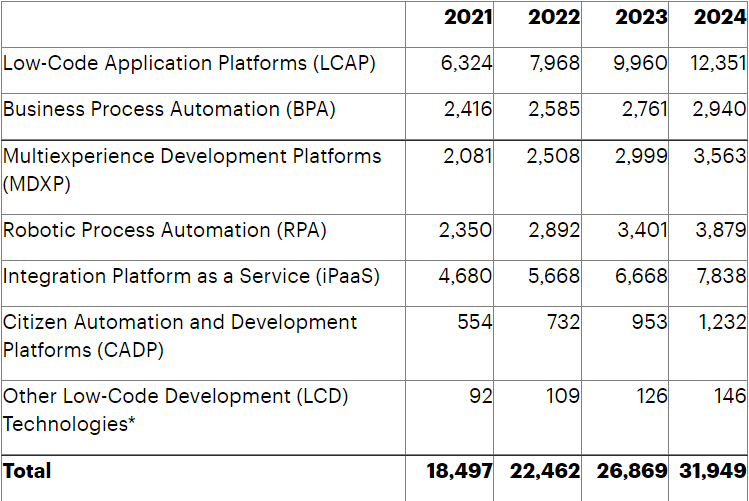
Source – Shutterstock
Low-code development technologies to thrive in 2023 – Here’s what you need to know
- The global market for low-code development technologies is anticipated to reach US$ 26.9 billion in 2023.
- Business technologists, hyper-automation, and composability will drive the use of low-code technologies through 2026.
Low-code development technologies have been prevalent in recent years because they make it possible for non-technical people to build software applications without having a deep understanding of programming. Organizations with limited IT resources may run into trouble when hiring sought-after tech talent to create cutting-edge applications, a reliance on IT that is reduced by low-code application platforms.
With low-code development, businesses can rely less on developers while quickly giving key stakeholders access to business-critical data. IT teams can develop, deploy, and deliver technologies to help enterprises achieve their digital transformation objectives with minimal coding experience.
A Gartner report states that the global market for low-code development technologies is anticipated to reach US$ 26.9 billion in 2023, up 19.6% from 2022. A rise in business technologists, enterprise-wide hyper-automation, and composable business activities will accelerate the adoption of low-code technologies through 2026.
According to Varsha Mehta, Senior Market Research Specialist at Gartner, businesses are increasingly using low-code development solutions to meet the demand for swift application delivery and highly customized automated workflows.
“Equipping both professional IT developers and non-IT personas — business technologists — with diverse low-code tools enables organizations to reach the level of digital competency and speed of delivery required for the modern agile environment,” said Mehta.
The market for low-code development technology is expected to expand by 25% to approximately US$ 10 billion in 2023, with low-code application platforms (LCAPs) making up much of the market.

Low-Code Development Technologies Revenue (Millions of U.S. Dollars). (Source – Gartner)
While LCAP is the largest market sector, the citizen automation development platform (CADP) is anticipated to grow fastest, with a growth rate of 30.2% predicted for 2023. Typical CADP use cases include automating workflows, developing web-based forms, connecting data and content across many software-as-a-service applications, and producing reports and data visualizations.
“The high cost of tech talent and a growing hybrid or borderless workforce will contribute to low-code technology adoption,” said Jason Wong, Distinguished VP Analyst, at Gartner. According to Gartner, by 2026, developers outside of formal IT departments will make up at least 80% of users of low-code development tools, up from 60% in 2021.
What is driving low-code adoption?
Due to growing demands for operational optimization, a widening skills gap, and mounting financial challenges, interest in hyper-automation continues to rise. According to Gartner, spending on software solutions that enable hyper-automation will exceed US$ 720 billion in 2023. This spending will be allocated to low-code development technologies like LCAP, iPaaS, RPA, CADP, and MXDP to support use cases involving process automation, integration, decision analytics, and intelligence.
Investments in low-code solutions that promote innovation and composable integration will rise as businesses adopt composable organizations. Composable organizations must create unique user experiences for new workflows and processes and effectively repurpose current packaged business capabilities (PBCs) for agile application development.
Low-code development solutions to check out:
The question now is determining what the right solution is. With so many options available, it can be difficult to decide which is the best fit for an organization. Here are some choices to play around with:
Appian
The Appian low-code platform offers design studios for citizen and professional developers to improve business and IT collaboration by incorporating processes, approvals, and change management for various developer personas. Without writing a single line of code, non-technical individuals may use this free platform to build everything from mobile apps to enterprise-wide systems.
Kissflow
Kissflow Low-Code enables business departments outside of IT, such as HR, Finance, and Procurement, to create enterprise-grade custom apps quickly and easily. Kissflow manages processes and workflows. The rule-based paradigm used by Kissflow eliminates the need for coding and enables the customization of workflows – which is suitable for all kinds of companies and industries.
Mendix
Mendix continues to offer cutting-edge enterprise low-code features useful for new use cases like the Internet of Things (IoT) and digital twins. Mendix is renowned for its core competencies, particularly in governance, integration support, and UX design.
Microsoft
Microsoft Power Apps, which includes entitlements for Power Automate and Dataverse, is the LCAP product offered by Microsoft. Power Apps has evolved from a platform for citizen developers to a tool that facilitates collaboration between business and IT users. Microsoft has accelerated the adoption of Power Apps at a rate unmatched by other LCAP providers by leveraging Microsoft 365 and Teams.
Outsystems
Outsystems often serves the banking, finance, insurance, and professional services sectors, and has a high percentage of small and large corporate customers. OutSystems provides cutting-edge low-code features, including AI-augmented development, native but proprietary continuous integration/continuous delivery (CI/CD), application testing, and more to help the rapid development of enterprise-grade applications.
Ultimately, choosing the right low-code development tool will depend on users’ specific needs and goals.
READ MORE
- Strategies for Democratizing GenAI
- The criticality of endpoint management in cybersecurity and operations
- Ethical AI: The renewed importance of safeguarding data and customer privacy in Generative AI applications
- How Japan balances AI-driven opportunities with cybersecurity needs
- Deploying SASE: Benchmarking your approach


